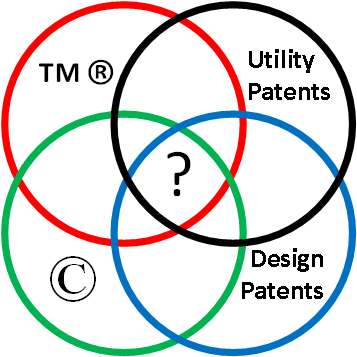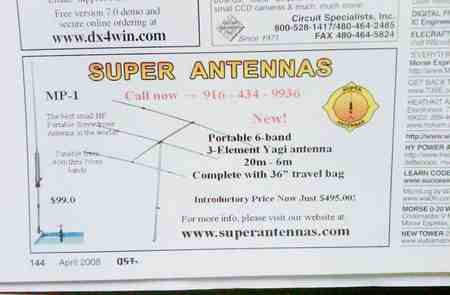Copyrights, Designs and Intellectual Property
Ah intellectual property…

It is just me or are various antenna designers misunderstanding how copyrights, patents and intellectual property work. Some seem to want to control how their designs are used despite placing them, apparently inadvertently, into the public domain or are at least losing any rights to license the design to others. Reading this WIPO web page reinforces the reality that if you do not patent your invention, others may make the same product by using your design with no requirement to pay for such use.
Observation
There are some antenna development web sites which have wording like this example from…
http://dg7ybn.de/…
“Republishing or distribution of designs or computer files is protected by common copyright laws even without mentioning them in explicit ways.”
…and this from G0KSC…
http://www.g0ksc.co.uk/3el-19mtr-boom-lfa.html…
“[. . .] and all G0KSC designs are copyright. Any ham can build for their own use or those of a friend. Where profit or commercial gain exists, express permission of G0KSC must be sought.”
…and this from…
http://www.g0ksc.co.uk/2013-yagis/5el-73mhz-radio-astronomy.html
“COMMERICALLY AVAILABLE FROM INNOVANTENNAS. NO OTHER COMPANY HAS COMMERCIAL USE RIGHTS OF ANY KIND”
Fantastic designs, awesome performance and laudable effort, but really “Use rights?” Who has what rights? Let’s explore…
Idea vs. Expression…
From Wikipedia…
The idea–expression divide or idea–expression dichotomy limits the scope of copyright protection by differentiating an idea from the expression or manifestation of that idea.
The European Union Software Directive, Article 1.2, for example, expressly excludes from copyright ideas and principles that underlie any element of a computer program, including those that underlie its interfaces.[1][2] In the United States the 1879 opinion of the Supreme Court in the case of Baker v. Selden[3] elaborated this doctrine, holding that while exclusive rights to the “useful art” (in this case bookkeeping) described in a book might be available by patent; only the description itself was protectable by copyright. In Harper & Row Publishers, Inc. v. Nation Enters., 471 U.S. 539, 556 (1985), the Supreme Court stated that “copyright’s idea/expression dichotomy ‘strike[s] a definitional balance between the First Amendment and the Copyright Act by permitting free communication of facts while still protecting an author’s expression.'” (internal citation omitted). Additionally, in Mazer v. Stein, 347 U.S. 201, 217 (1954), the Supreme Court stated “Unlike a patent, a copyright gives no exclusive right to the art disclosed; protection is given only to the expression of the idea—not the idea itself.”
Some of the criticism directed at “intellectual property” is based on the confusion between patents, which may confer proprietary rights in relation to general ideas and concepts per se when construed as methods, and copyrights, which cannot confer such rights.
…and from the US Copyright Office…
Copyright law does not protect ideas, methods, or systems. Copyright protection is therefore not available for ideas or procedures for doing, making, or building things; scientific or technical methods or discoveries; business operations or procedures; mathematical principles; formulas or algorithms; or any other concept, process, or method of operation.
…and a final example from IP Watchdog…
Copyrights protect expression and patents protect inventions, and neither protect ideas. [. . .] The moral of the story is that ideas alone cannot be protected, so you need to think in terms of invention.
Publication of Prior Art
Pumping your design into the public domain seems fantastically easy. This MIT site…
http://web.mit.edu/tlo/www/community/preserving_patent_rights.html
…offers this…
In order to act as a patent bar, the disclosure must be “enabling”–that is, it must teach someone “of ordinary skill in the art” how to actually duplicate the invention.
An offer for sale, even if it does not teach someone how to make the invention, is a bar to patentability (after the grace period) in the U.S., but is not a bar in Europe if it does not “enable”.
It seems an easy argument the web site publication of any sort of build drawing or antenna model is an enabling disclosure of the design it describes. I suppose the question of publishing date might come into play, but a date can be inferred from date-stamped photos of happy hams’ antennas proudly made from the “enabling disclosures.” Perhaps this is grey area.
One hard example of “offer for sale” is patent #US8144070 (from Super Antenna)…
…which has a date of May 1st 2009, but was offered for sale in April 2008, 13 months before…
Whoops… we might have a timing problem here. It seems someone didn’t disclose this detail or, perhaps, this isn’t the same thing described in the patent. Who knows.
It seems quite clear the various incredible designs from folks like G0KSC are being placed into the public domain at a tremendous rate. There are Patent Pending words on some of the web pages, but thus far I’ve not found a single patent or patent application in the EU or US database. I’ll keep trying. In the meantime, the posted dimensional drawings, cutting lists and model files definitely serve as perfect enabling documentation and serve as prior art albeit with difficult to ascertain dates.
Bluffing?
In poker a pair of balls beats everything. In intellectual property I’m not so sure. Are the antenna design web sites trying to pull one over on us or just over stating their claims to IP they no longer own just in case they actually still do.
Compete Fairly
Rather than spend so much effort trying to pull the wool over everyone’s eyes with the illusion of design protection via copyright, you might be well advised to simply make your product better than others. Take it as a compliment someone else might like to make your design. Make your money quick, however, before someone <cough>China</cough> takes notice, calls your bluff, and makes a 100% legitimate knockoff; Good luck fighting that.
Questions
- Do the creators of antenna designs, like DG7YBN and G0KSC, understand that, short of patenting, they are pumping their designs into the public domain?
- Can a designer who spills their design into the public domain control how that design is used?
- Anyone know of any successful prosecution of design “infringements” involving the above or any allegedly public domain designs?
- Have I missed something here?
Comments welcome from IP professionals only.

I must say I'm not confident I can always separate an idea from its expression.
Point taken. Therein lies the problem I suppose. Folks who copyright their expression are inadvertently exposing the idea within.
And the I found the "Copyright © John Huggins" in the footer of this blogs website. Makes my day. 73, DG7YBN.
Yup… because I know the difference between copyrights and patents.